BIS1100: Introduction to Business and Organisations - RBS Report
VerifiedAdded on 2020/10/04
|18
|5366
|41
Report
AI Summary
This report provides a comprehensive analysis of the Royal Bank of Scotland (RBS), examining its background, business model, and the services it offers to customers. It delves into the bank's revenue streams, market analysis within the UK banking sector, and key competitors' strategies. The report also explores the supply chain management involved in the production and distribution of bank notes, outlining upstream, mid-stream, and downstream processes. Furthermore, it addresses the role of information and communication technologies (ICT) within RBS, analyzes the organization's culture and structure, and identifies ethical issues faced by the bank. The report concludes with an overview of the key findings and insights into RBS's operations and challenges.
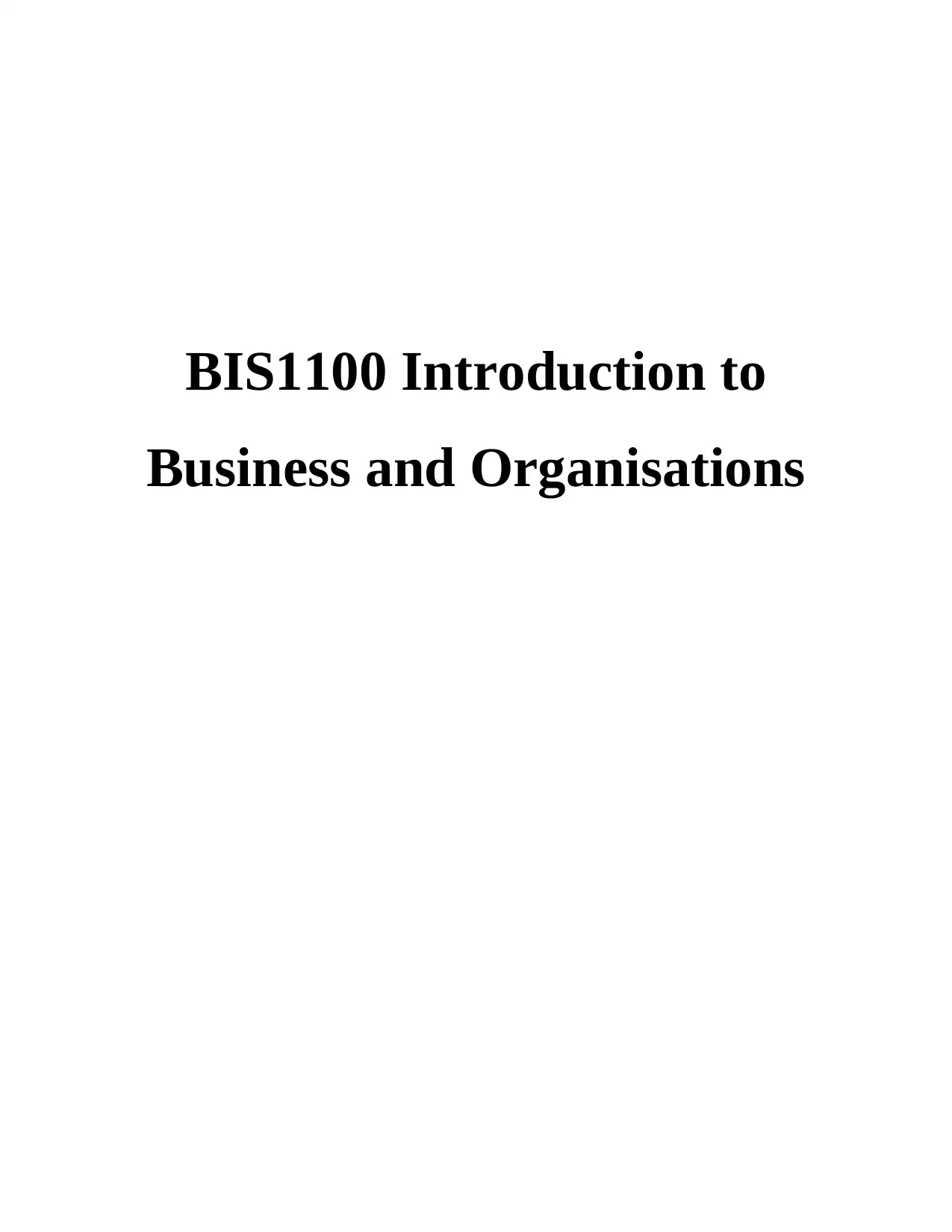
BIS1100 Introduction to
Business and Organisations
Business and Organisations
Paraphrase This Document
Need a fresh take? Get an instant paraphrase of this document with our AI Paraphraser
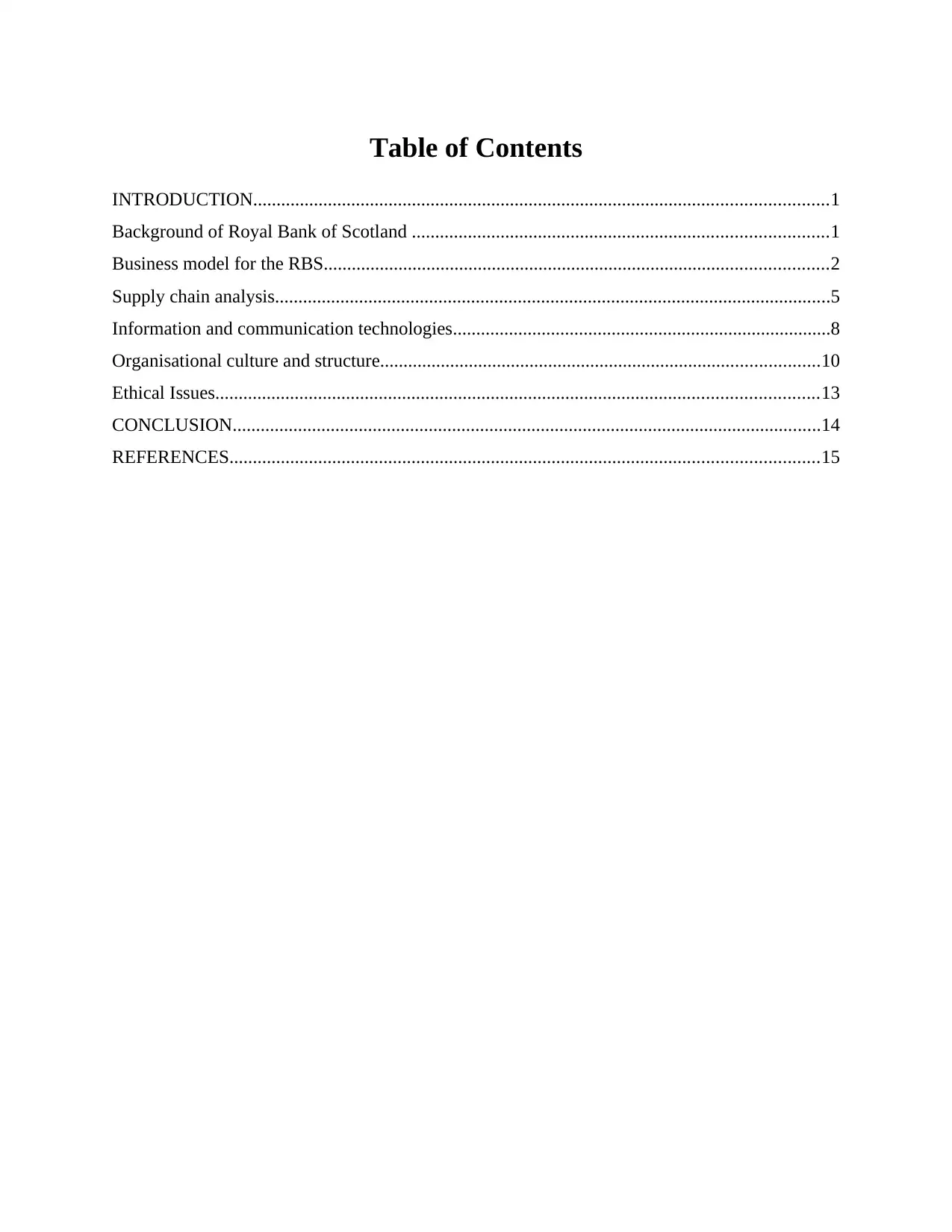
Table of Contents
INTRODUCTION...........................................................................................................................1
Background of Royal Bank of Scotland .........................................................................................1
Business model for the RBS............................................................................................................2
Supply chain analysis.......................................................................................................................5
Information and communication technologies.................................................................................8
Organisational culture and structure..............................................................................................10
Ethical Issues.................................................................................................................................13
CONCLUSION..............................................................................................................................14
REFERENCES..............................................................................................................................15
INTRODUCTION...........................................................................................................................1
Background of Royal Bank of Scotland .........................................................................................1
Business model for the RBS............................................................................................................2
Supply chain analysis.......................................................................................................................5
Information and communication technologies.................................................................................8
Organisational culture and structure..............................................................................................10
Ethical Issues.................................................................................................................................13
CONCLUSION..............................................................................................................................14
REFERENCES..............................................................................................................................15
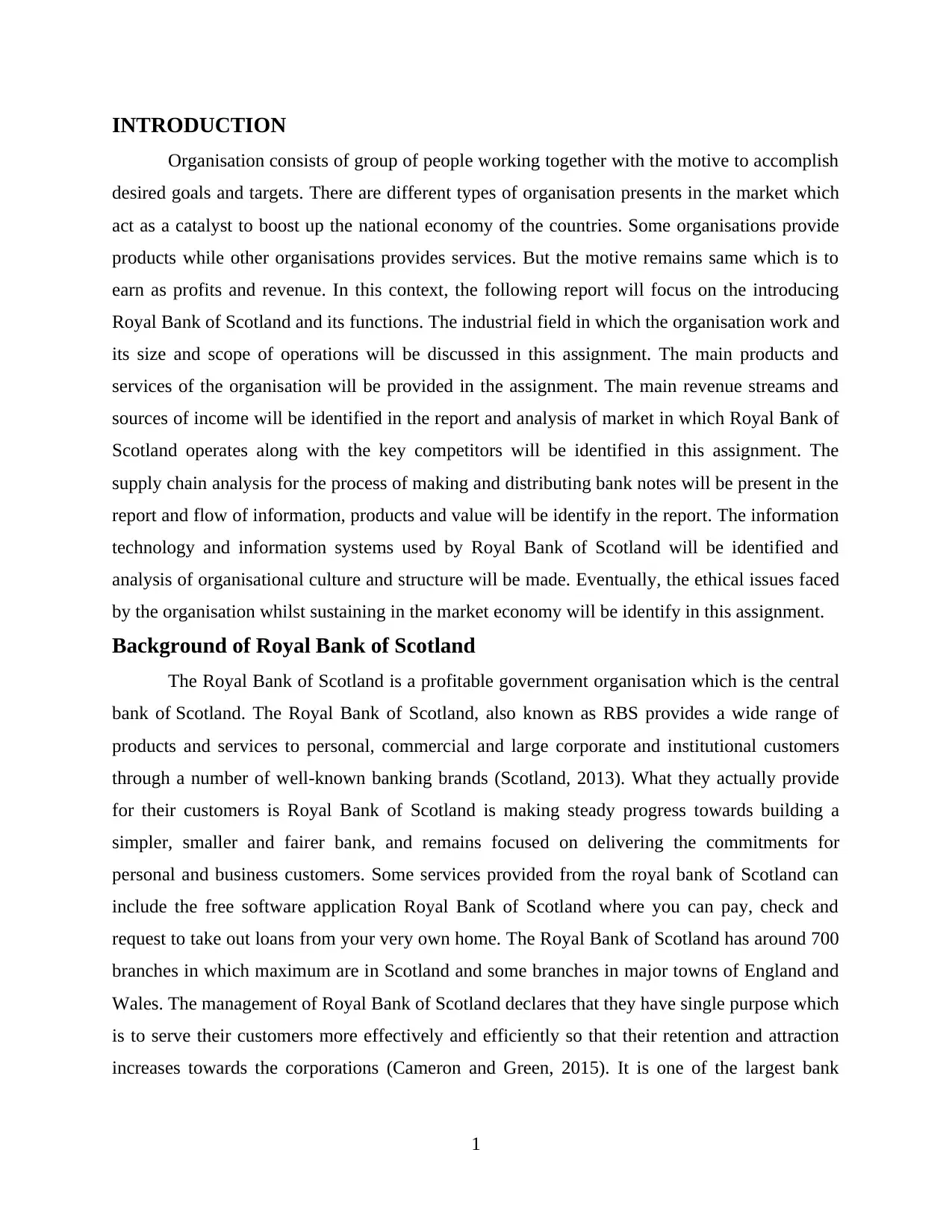
INTRODUCTION
Organisation consists of group of people working together with the motive to accomplish
desired goals and targets. There are different types of organisation presents in the market which
act as a catalyst to boost up the national economy of the countries. Some organisations provide
products while other organisations provides services. But the motive remains same which is to
earn as profits and revenue. In this context, the following report will focus on the introducing
Royal Bank of Scotland and its functions. The industrial field in which the organisation work and
its size and scope of operations will be discussed in this assignment. The main products and
services of the organisation will be provided in the assignment. The main revenue streams and
sources of income will be identified in the report and analysis of market in which Royal Bank of
Scotland operates along with the key competitors will be identified in this assignment. The
supply chain analysis for the process of making and distributing bank notes will be present in the
report and flow of information, products and value will be identify in the report. The information
technology and information systems used by Royal Bank of Scotland will be identified and
analysis of organisational culture and structure will be made. Eventually, the ethical issues faced
by the organisation whilst sustaining in the market economy will be identify in this assignment.
Background of Royal Bank of Scotland
The Royal Bank of Scotland is a profitable government organisation which is the central
bank of Scotland. The Royal Bank of Scotland, also known as RBS provides a wide range of
products and services to personal, commercial and large corporate and institutional customers
through a number of well-known banking brands (Scotland, 2013). What they actually provide
for their customers is Royal Bank of Scotland is making steady progress towards building a
simpler, smaller and fairer bank, and remains focused on delivering the commitments for
personal and business customers. Some services provided from the royal bank of Scotland can
include the free software application Royal Bank of Scotland where you can pay, check and
request to take out loans from your very own home. The Royal Bank of Scotland has around 700
branches in which maximum are in Scotland and some branches in major towns of England and
Wales. The management of Royal Bank of Scotland declares that they have single purpose which
is to serve their customers more effectively and efficiently so that their retention and attraction
increases towards the corporations (Cameron and Green, 2015). It is one of the largest bank
1
Organisation consists of group of people working together with the motive to accomplish
desired goals and targets. There are different types of organisation presents in the market which
act as a catalyst to boost up the national economy of the countries. Some organisations provide
products while other organisations provides services. But the motive remains same which is to
earn as profits and revenue. In this context, the following report will focus on the introducing
Royal Bank of Scotland and its functions. The industrial field in which the organisation work and
its size and scope of operations will be discussed in this assignment. The main products and
services of the organisation will be provided in the assignment. The main revenue streams and
sources of income will be identified in the report and analysis of market in which Royal Bank of
Scotland operates along with the key competitors will be identified in this assignment. The
supply chain analysis for the process of making and distributing bank notes will be present in the
report and flow of information, products and value will be identify in the report. The information
technology and information systems used by Royal Bank of Scotland will be identified and
analysis of organisational culture and structure will be made. Eventually, the ethical issues faced
by the organisation whilst sustaining in the market economy will be identify in this assignment.
Background of Royal Bank of Scotland
The Royal Bank of Scotland is a profitable government organisation which is the central
bank of Scotland. The Royal Bank of Scotland, also known as RBS provides a wide range of
products and services to personal, commercial and large corporate and institutional customers
through a number of well-known banking brands (Scotland, 2013). What they actually provide
for their customers is Royal Bank of Scotland is making steady progress towards building a
simpler, smaller and fairer bank, and remains focused on delivering the commitments for
personal and business customers. Some services provided from the royal bank of Scotland can
include the free software application Royal Bank of Scotland where you can pay, check and
request to take out loans from your very own home. The Royal Bank of Scotland has around 700
branches in which maximum are in Scotland and some branches in major towns of England and
Wales. The management of Royal Bank of Scotland declares that they have single purpose which
is to serve their customers more effectively and efficiently so that their retention and attraction
increases towards the corporations (Cameron and Green, 2015). It is one of the largest bank
1
⊘ This is a preview!⊘
Do you want full access?
Subscribe today to unlock all pages.

Trusted by 1+ million students worldwide
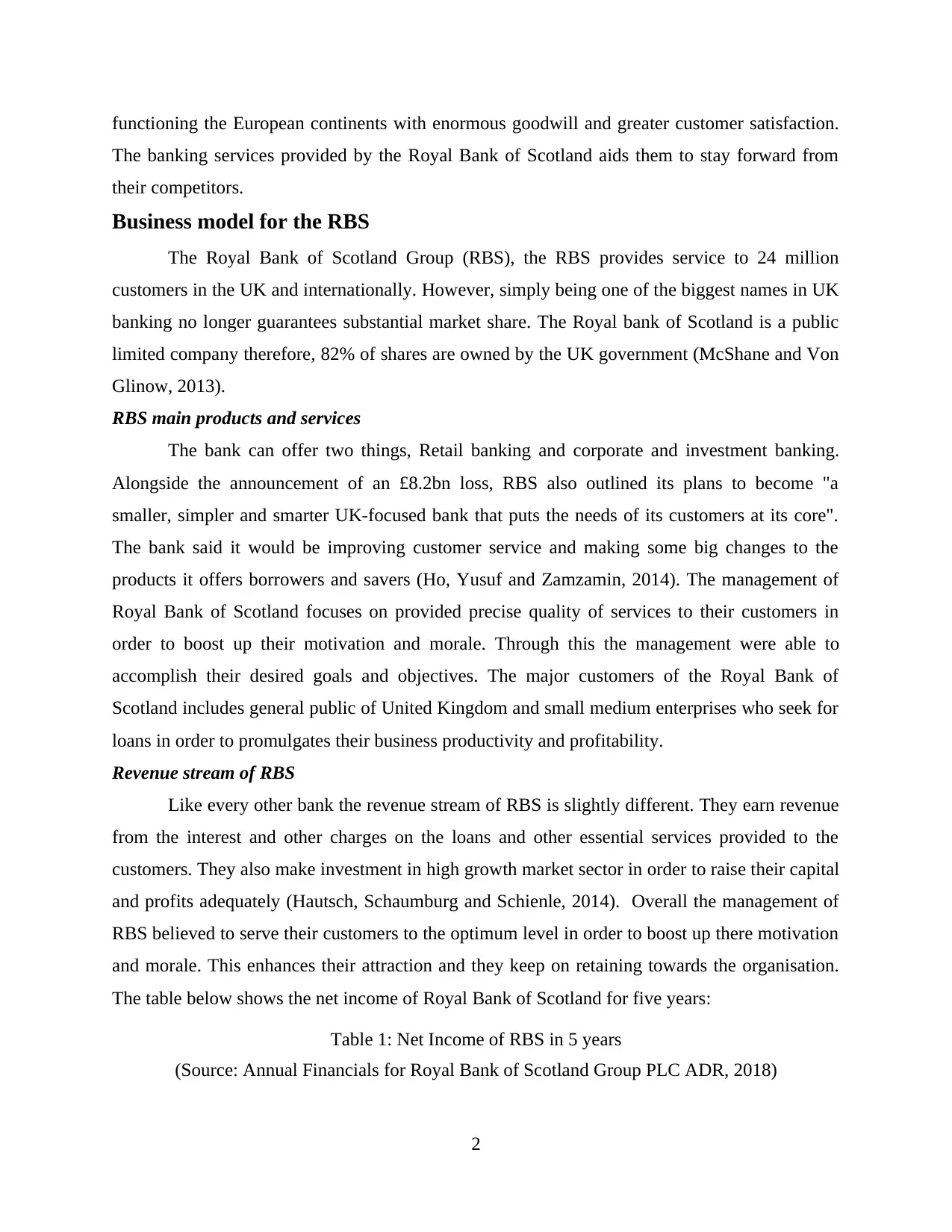
functioning the European continents with enormous goodwill and greater customer satisfaction.
The banking services provided by the Royal Bank of Scotland aids them to stay forward from
their competitors.
Business model for the RBS
The Royal Bank of Scotland Group (RBS), the RBS provides service to 24 million
customers in the UK and internationally. However, simply being one of the biggest names in UK
banking no longer guarantees substantial market share. The Royal bank of Scotland is a public
limited company therefore, 82% of shares are owned by the UK government (McShane and Von
Glinow, 2013).
RBS main products and services
The bank can offer two things, Retail banking and corporate and investment banking.
Alongside the announcement of an £8.2bn loss, RBS also outlined its plans to become "a
smaller, simpler and smarter UK-focused bank that puts the needs of its customers at its core".
The bank said it would be improving customer service and making some big changes to the
products it offers borrowers and savers (Ho, Yusuf and Zamzamin, 2014). The management of
Royal Bank of Scotland focuses on provided precise quality of services to their customers in
order to boost up their motivation and morale. Through this the management were able to
accomplish their desired goals and objectives. The major customers of the Royal Bank of
Scotland includes general public of United Kingdom and small medium enterprises who seek for
loans in order to promulgates their business productivity and profitability.
Revenue stream of RBS
Like every other bank the revenue stream of RBS is slightly different. They earn revenue
from the interest and other charges on the loans and other essential services provided to the
customers. They also make investment in high growth market sector in order to raise their capital
and profits adequately (Hautsch, Schaumburg and Schienle, 2014). Overall the management of
RBS believed to serve their customers to the optimum level in order to boost up there motivation
and morale. This enhances their attraction and they keep on retaining towards the organisation.
The table below shows the net income of Royal Bank of Scotland for five years:
Table 1: Net Income of RBS in 5 years
(Source: Annual Financials for Royal Bank of Scotland Group PLC ADR, 2018)
2
The banking services provided by the Royal Bank of Scotland aids them to stay forward from
their competitors.
Business model for the RBS
The Royal Bank of Scotland Group (RBS), the RBS provides service to 24 million
customers in the UK and internationally. However, simply being one of the biggest names in UK
banking no longer guarantees substantial market share. The Royal bank of Scotland is a public
limited company therefore, 82% of shares are owned by the UK government (McShane and Von
Glinow, 2013).
RBS main products and services
The bank can offer two things, Retail banking and corporate and investment banking.
Alongside the announcement of an £8.2bn loss, RBS also outlined its plans to become "a
smaller, simpler and smarter UK-focused bank that puts the needs of its customers at its core".
The bank said it would be improving customer service and making some big changes to the
products it offers borrowers and savers (Ho, Yusuf and Zamzamin, 2014). The management of
Royal Bank of Scotland focuses on provided precise quality of services to their customers in
order to boost up their motivation and morale. Through this the management were able to
accomplish their desired goals and objectives. The major customers of the Royal Bank of
Scotland includes general public of United Kingdom and small medium enterprises who seek for
loans in order to promulgates their business productivity and profitability.
Revenue stream of RBS
Like every other bank the revenue stream of RBS is slightly different. They earn revenue
from the interest and other charges on the loans and other essential services provided to the
customers. They also make investment in high growth market sector in order to raise their capital
and profits adequately (Hautsch, Schaumburg and Schienle, 2014). Overall the management of
RBS believed to serve their customers to the optimum level in order to boost up there motivation
and morale. This enhances their attraction and they keep on retaining towards the organisation.
The table below shows the net income of Royal Bank of Scotland for five years:
Table 1: Net Income of RBS in 5 years
(Source: Annual Financials for Royal Bank of Scotland Group PLC ADR, 2018)
2
Paraphrase This Document
Need a fresh take? Get an instant paraphrase of this document with our AI Paraphraser
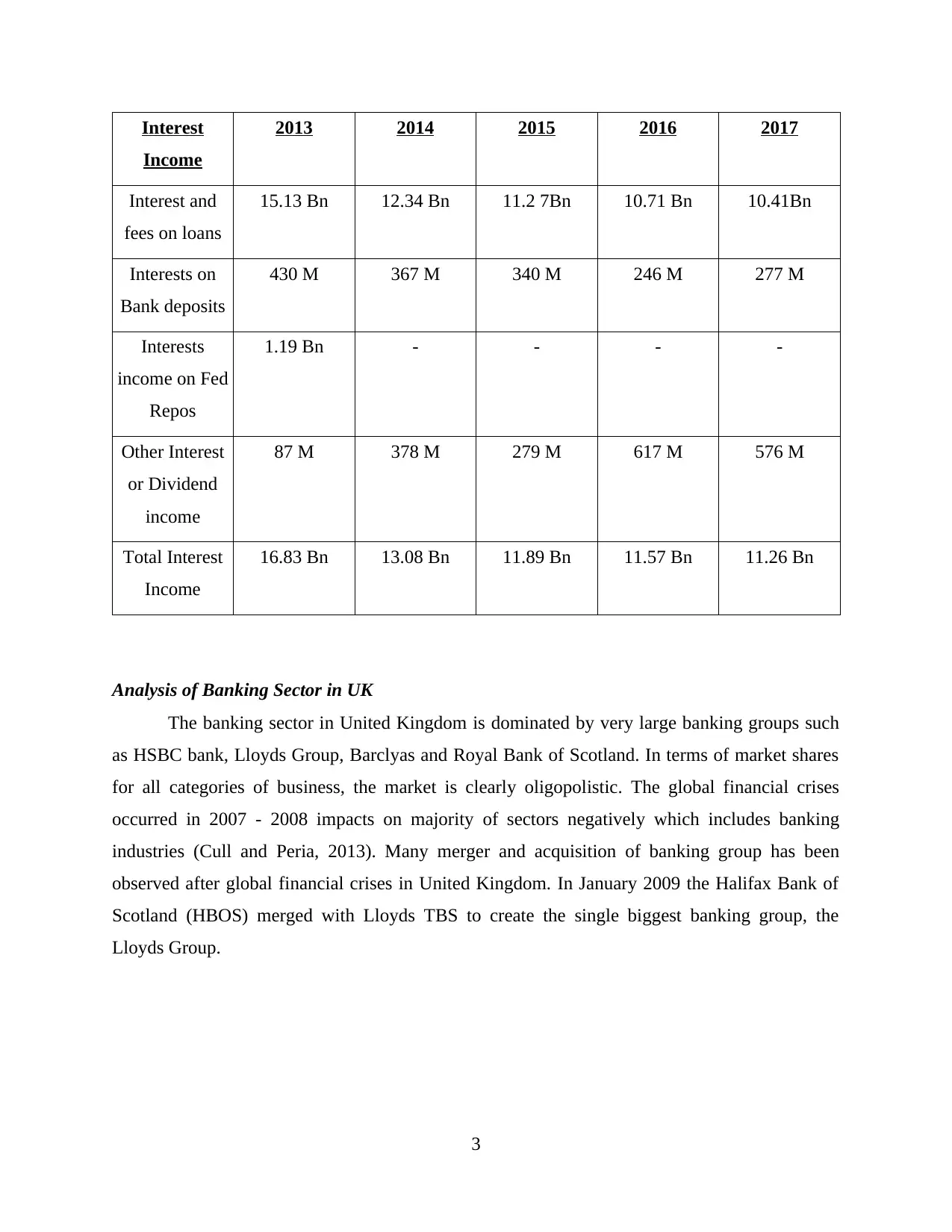
Interest
Income
2013 2014 2015 2016 2017
Interest and
fees on loans
15.13 Bn 12.34 Bn 11.2 7Bn 10.71 Bn 10.41Bn
Interests on
Bank deposits
430 M 367 M 340 M 246 M 277 M
Interests
income on Fed
Repos
1.19 Bn - - - -
Other Interest
or Dividend
income
87 M 378 M 279 M 617 M 576 M
Total Interest
Income
16.83 Bn 13.08 Bn 11.89 Bn 11.57 Bn 11.26 Bn
Analysis of Banking Sector in UK
The banking sector in United Kingdom is dominated by very large banking groups such
as HSBC bank, Lloyds Group, Barclyas and Royal Bank of Scotland. In terms of market shares
for all categories of business, the market is clearly oligopolistic. The global financial crises
occurred in 2007 - 2008 impacts on majority of sectors negatively which includes banking
industries (Cull and Peria, 2013). Many merger and acquisition of banking group has been
observed after global financial crises in United Kingdom. In January 2009 the Halifax Bank of
Scotland (HBOS) merged with Lloyds TBS to create the single biggest banking group, the
Lloyds Group.
3
Income
2013 2014 2015 2016 2017
Interest and
fees on loans
15.13 Bn 12.34 Bn 11.2 7Bn 10.71 Bn 10.41Bn
Interests on
Bank deposits
430 M 367 M 340 M 246 M 277 M
Interests
income on Fed
Repos
1.19 Bn - - - -
Other Interest
or Dividend
income
87 M 378 M 279 M 617 M 576 M
Total Interest
Income
16.83 Bn 13.08 Bn 11.89 Bn 11.57 Bn 11.26 Bn
Analysis of Banking Sector in UK
The banking sector in United Kingdom is dominated by very large banking groups such
as HSBC bank, Lloyds Group, Barclyas and Royal Bank of Scotland. In terms of market shares
for all categories of business, the market is clearly oligopolistic. The global financial crises
occurred in 2007 - 2008 impacts on majority of sectors negatively which includes banking
industries (Cull and Peria, 2013). Many merger and acquisition of banking group has been
observed after global financial crises in United Kingdom. In January 2009 the Halifax Bank of
Scotland (HBOS) merged with Lloyds TBS to create the single biggest banking group, the
Lloyds Group.
3
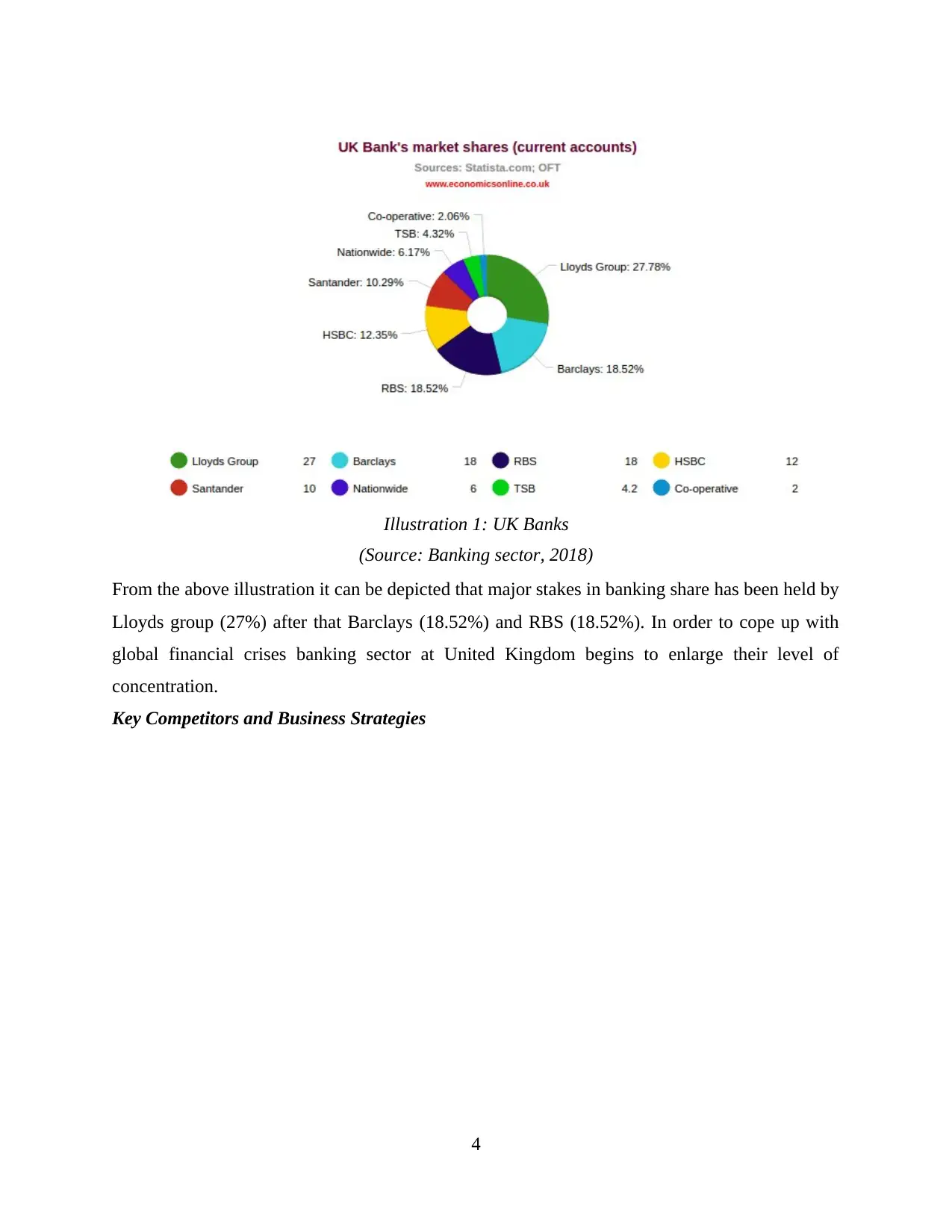
From the above illustration it can be depicted that major stakes in banking share has been held by
Lloyds group (27%) after that Barclays (18.52%) and RBS (18.52%). In order to cope up with
global financial crises banking sector at United Kingdom begins to enlarge their level of
concentration.
Key Competitors and Business Strategies
4
Illustration 1: UK Banks
(Source: Banking sector, 2018)
Lloyds group (27%) after that Barclays (18.52%) and RBS (18.52%). In order to cope up with
global financial crises banking sector at United Kingdom begins to enlarge their level of
concentration.
Key Competitors and Business Strategies
4
Illustration 1: UK Banks
(Source: Banking sector, 2018)
⊘ This is a preview!⊘
Do you want full access?
Subscribe today to unlock all pages.

Trusted by 1+ million students worldwide
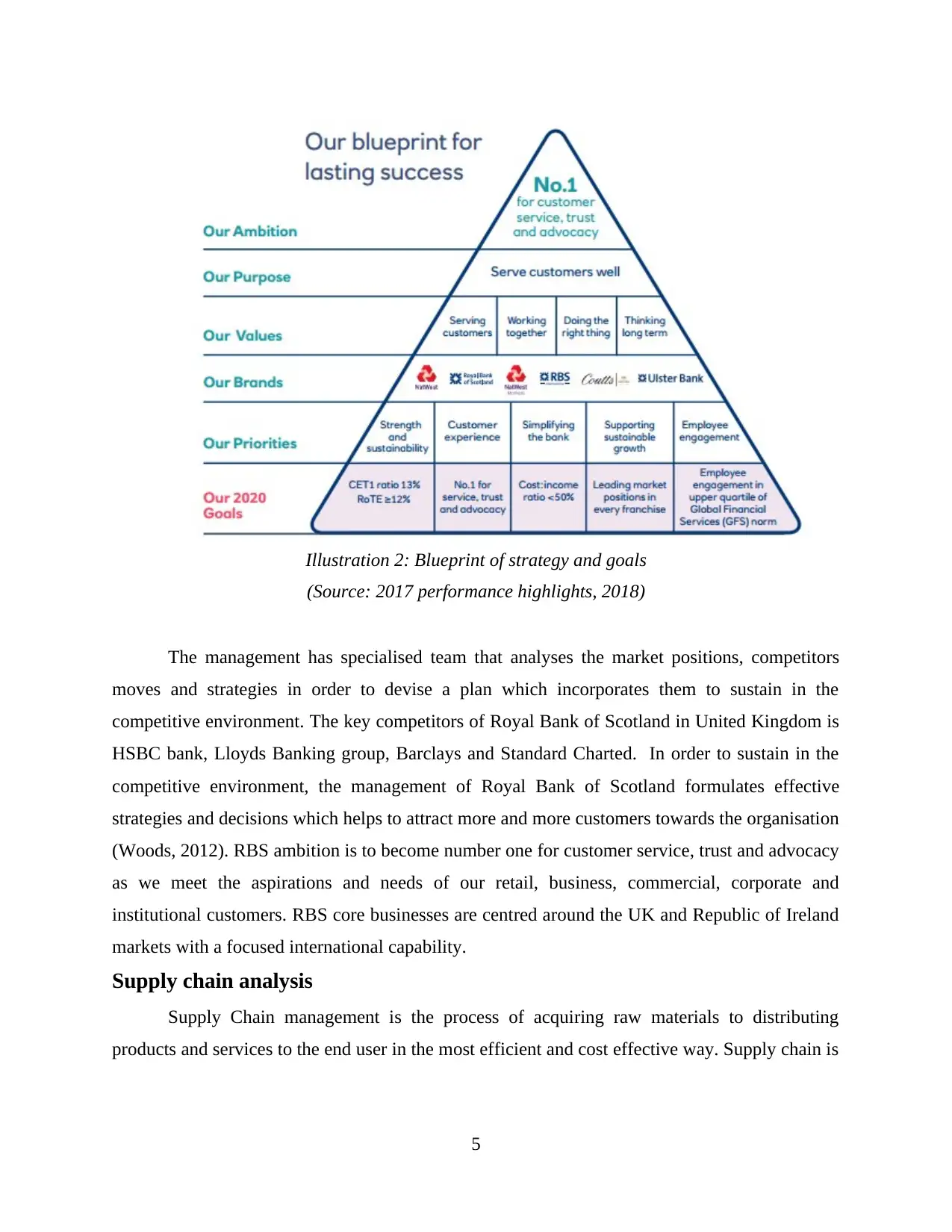
The management has specialised team that analyses the market positions, competitors
moves and strategies in order to devise a plan which incorporates them to sustain in the
competitive environment. The key competitors of Royal Bank of Scotland in United Kingdom is
HSBC bank, Lloyds Banking group, Barclays and Standard Charted. In order to sustain in the
competitive environment, the management of Royal Bank of Scotland formulates effective
strategies and decisions which helps to attract more and more customers towards the organisation
(Woods, 2012). RBS ambition is to become number one for customer service, trust and advocacy
as we meet the aspirations and needs of our retail, business, commercial, corporate and
institutional customers. RBS core businesses are centred around the UK and Republic of Ireland
markets with a focused international capability.
Supply chain analysis
Supply Chain management is the process of acquiring raw materials to distributing
products and services to the end user in the most efficient and cost effective way. Supply chain is
5
Illustration 2: Blueprint of strategy and goals
(Source: 2017 performance highlights, 2018)
moves and strategies in order to devise a plan which incorporates them to sustain in the
competitive environment. The key competitors of Royal Bank of Scotland in United Kingdom is
HSBC bank, Lloyds Banking group, Barclays and Standard Charted. In order to sustain in the
competitive environment, the management of Royal Bank of Scotland formulates effective
strategies and decisions which helps to attract more and more customers towards the organisation
(Woods, 2012). RBS ambition is to become number one for customer service, trust and advocacy
as we meet the aspirations and needs of our retail, business, commercial, corporate and
institutional customers. RBS core businesses are centred around the UK and Republic of Ireland
markets with a focused international capability.
Supply chain analysis
Supply Chain management is the process of acquiring raw materials to distributing
products and services to the end user in the most efficient and cost effective way. Supply chain is
5
Illustration 2: Blueprint of strategy and goals
(Source: 2017 performance highlights, 2018)
Paraphrase This Document
Need a fresh take? Get an instant paraphrase of this document with our AI Paraphraser
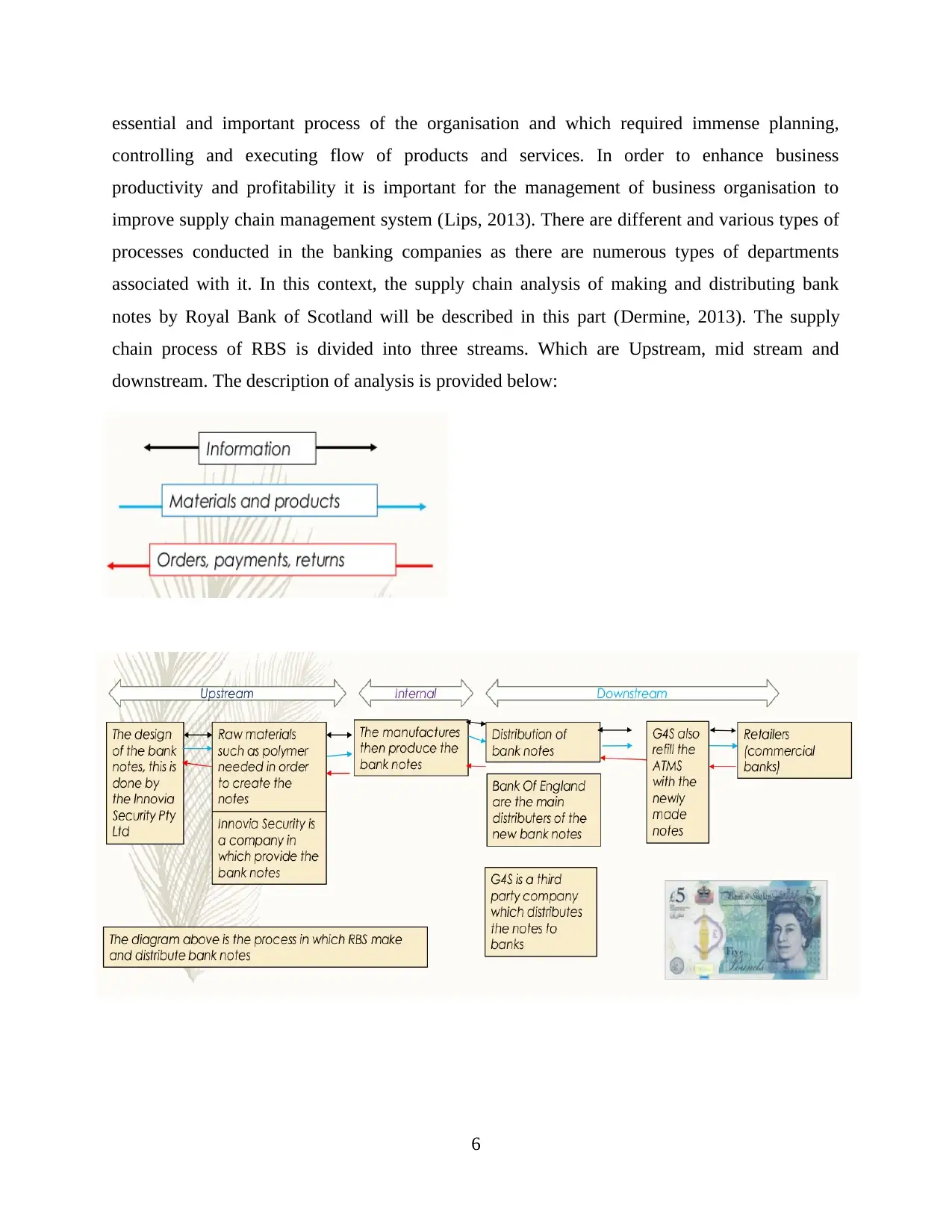
essential and important process of the organisation and which required immense planning,
controlling and executing flow of products and services. In order to enhance business
productivity and profitability it is important for the management of business organisation to
improve supply chain management system (Lips, 2013). There are different and various types of
processes conducted in the banking companies as there are numerous types of departments
associated with it. In this context, the supply chain analysis of making and distributing bank
notes by Royal Bank of Scotland will be described in this part (Dermine, 2013). The supply
chain process of RBS is divided into three streams. Which are Upstream, mid stream and
downstream. The description of analysis is provided below:
6
controlling and executing flow of products and services. In order to enhance business
productivity and profitability it is important for the management of business organisation to
improve supply chain management system (Lips, 2013). There are different and various types of
processes conducted in the banking companies as there are numerous types of departments
associated with it. In this context, the supply chain analysis of making and distributing bank
notes by Royal Bank of Scotland will be described in this part (Dermine, 2013). The supply
chain process of RBS is divided into three streams. Which are Upstream, mid stream and
downstream. The description of analysis is provided below:
6
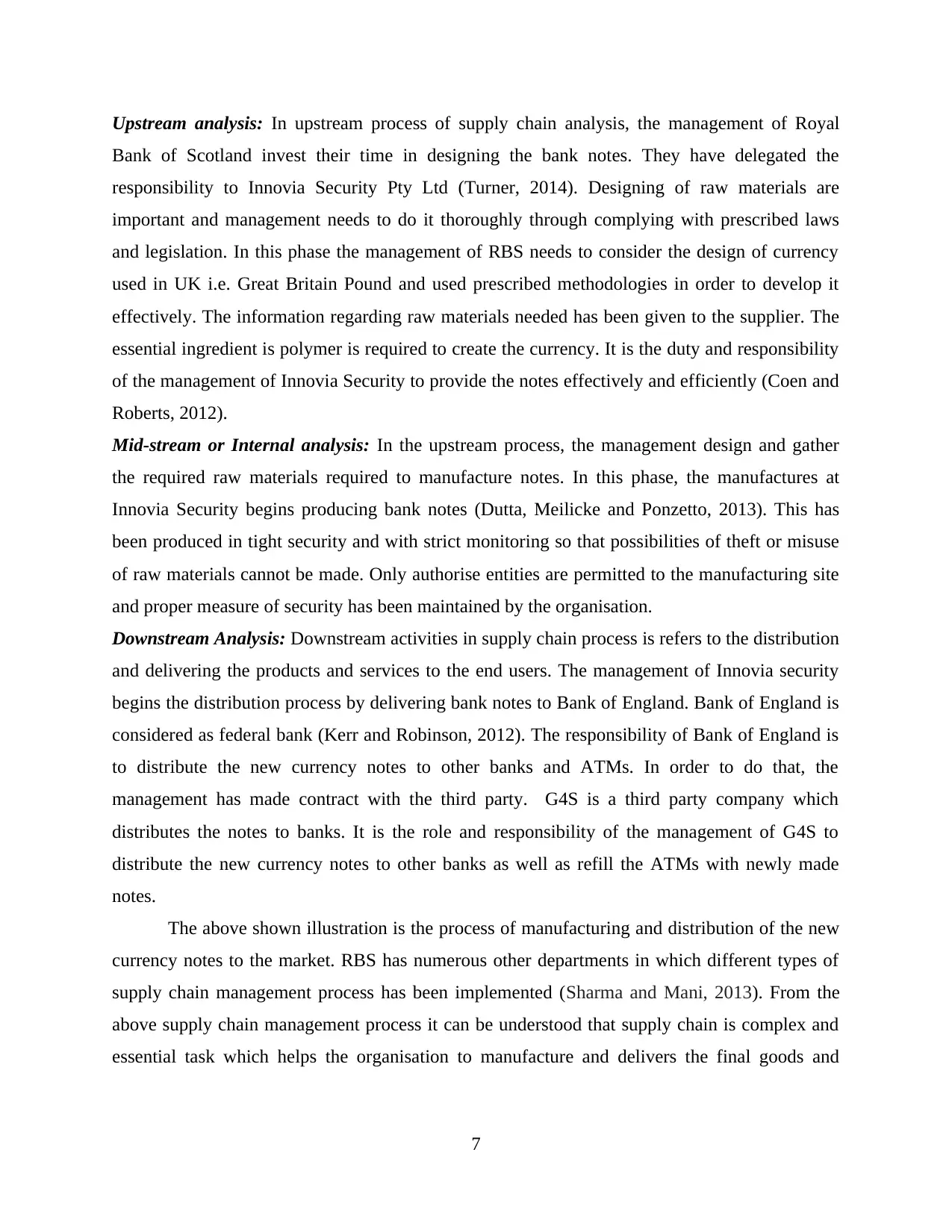
Upstream analysis: In upstream process of supply chain analysis, the management of Royal
Bank of Scotland invest their time in designing the bank notes. They have delegated the
responsibility to Innovia Security Pty Ltd (Turner, 2014). Designing of raw materials are
important and management needs to do it thoroughly through complying with prescribed laws
and legislation. In this phase the management of RBS needs to consider the design of currency
used in UK i.e. Great Britain Pound and used prescribed methodologies in order to develop it
effectively. The information regarding raw materials needed has been given to the supplier. The
essential ingredient is polymer is required to create the currency. It is the duty and responsibility
of the management of Innovia Security to provide the notes effectively and efficiently (Coen and
Roberts, 2012).
Mid-stream or Internal analysis: In the upstream process, the management design and gather
the required raw materials required to manufacture notes. In this phase, the manufactures at
Innovia Security begins producing bank notes (Dutta, Meilicke and Ponzetto, 2013). This has
been produced in tight security and with strict monitoring so that possibilities of theft or misuse
of raw materials cannot be made. Only authorise entities are permitted to the manufacturing site
and proper measure of security has been maintained by the organisation.
Downstream Analysis: Downstream activities in supply chain process is refers to the distribution
and delivering the products and services to the end users. The management of Innovia security
begins the distribution process by delivering bank notes to Bank of England. Bank of England is
considered as federal bank (Kerr and Robinson, 2012). The responsibility of Bank of England is
to distribute the new currency notes to other banks and ATMs. In order to do that, the
management has made contract with the third party. G4S is a third party company which
distributes the notes to banks. It is the role and responsibility of the management of G4S to
distribute the new currency notes to other banks as well as refill the ATMs with newly made
notes.
The above shown illustration is the process of manufacturing and distribution of the new
currency notes to the market. RBS has numerous other departments in which different types of
supply chain management process has been implemented (Sharma and Mani, 2013). From the
above supply chain management process it can be understood that supply chain is complex and
essential task which helps the organisation to manufacture and delivers the final goods and
7
Bank of Scotland invest their time in designing the bank notes. They have delegated the
responsibility to Innovia Security Pty Ltd (Turner, 2014). Designing of raw materials are
important and management needs to do it thoroughly through complying with prescribed laws
and legislation. In this phase the management of RBS needs to consider the design of currency
used in UK i.e. Great Britain Pound and used prescribed methodologies in order to develop it
effectively. The information regarding raw materials needed has been given to the supplier. The
essential ingredient is polymer is required to create the currency. It is the duty and responsibility
of the management of Innovia Security to provide the notes effectively and efficiently (Coen and
Roberts, 2012).
Mid-stream or Internal analysis: In the upstream process, the management design and gather
the required raw materials required to manufacture notes. In this phase, the manufactures at
Innovia Security begins producing bank notes (Dutta, Meilicke and Ponzetto, 2013). This has
been produced in tight security and with strict monitoring so that possibilities of theft or misuse
of raw materials cannot be made. Only authorise entities are permitted to the manufacturing site
and proper measure of security has been maintained by the organisation.
Downstream Analysis: Downstream activities in supply chain process is refers to the distribution
and delivering the products and services to the end users. The management of Innovia security
begins the distribution process by delivering bank notes to Bank of England. Bank of England is
considered as federal bank (Kerr and Robinson, 2012). The responsibility of Bank of England is
to distribute the new currency notes to other banks and ATMs. In order to do that, the
management has made contract with the third party. G4S is a third party company which
distributes the notes to banks. It is the role and responsibility of the management of G4S to
distribute the new currency notes to other banks as well as refill the ATMs with newly made
notes.
The above shown illustration is the process of manufacturing and distribution of the new
currency notes to the market. RBS has numerous other departments in which different types of
supply chain management process has been implemented (Sharma and Mani, 2013). From the
above supply chain management process it can be understood that supply chain is complex and
essential task which helps the organisation to manufacture and delivers the final goods and
7
⊘ This is a preview!⊘
Do you want full access?
Subscribe today to unlock all pages.

Trusted by 1+ million students worldwide
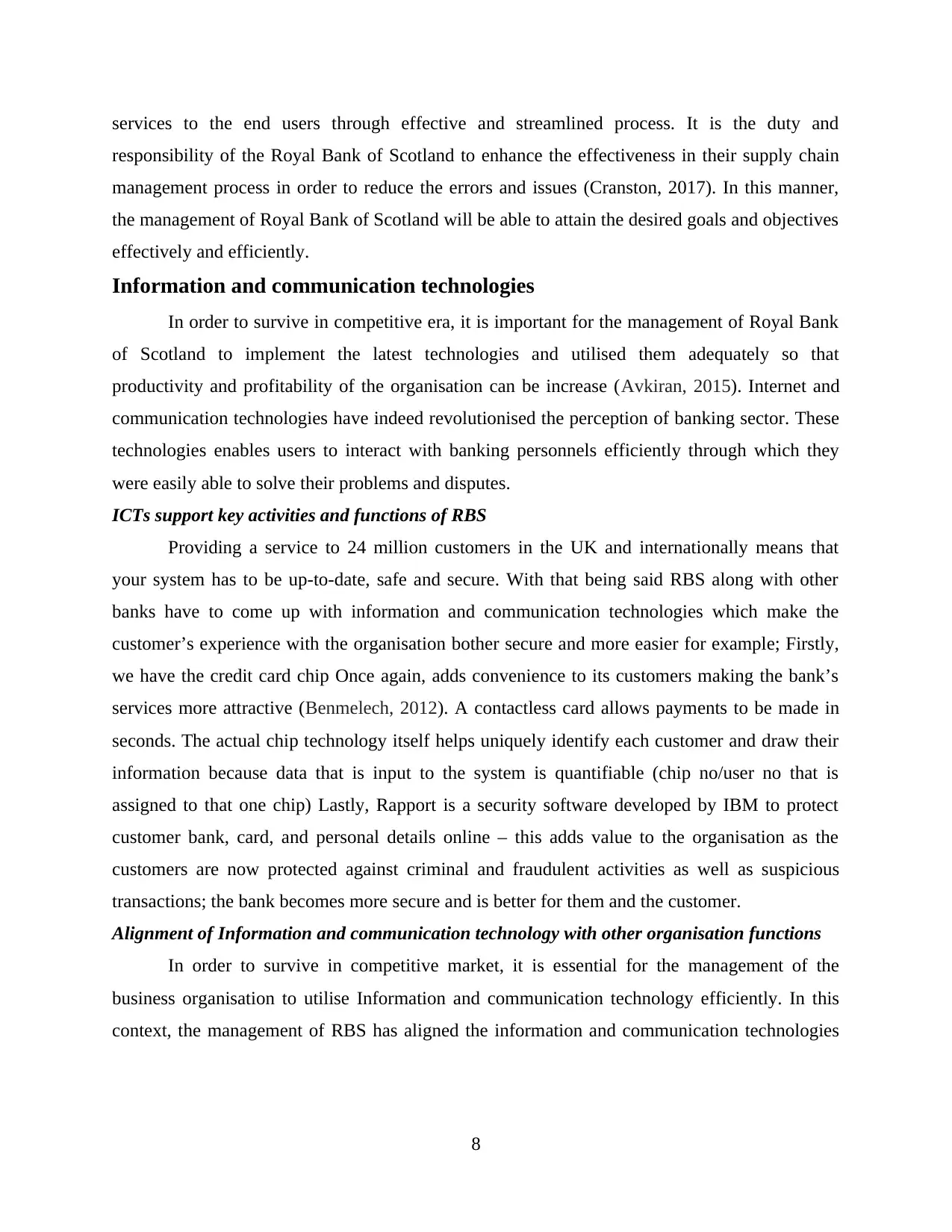
services to the end users through effective and streamlined process. It is the duty and
responsibility of the Royal Bank of Scotland to enhance the effectiveness in their supply chain
management process in order to reduce the errors and issues (Cranston, 2017). In this manner,
the management of Royal Bank of Scotland will be able to attain the desired goals and objectives
effectively and efficiently.
Information and communication technologies
In order to survive in competitive era, it is important for the management of Royal Bank
of Scotland to implement the latest technologies and utilised them adequately so that
productivity and profitability of the organisation can be increase (Avkiran, 2015). Internet and
communication technologies have indeed revolutionised the perception of banking sector. These
technologies enables users to interact with banking personnels efficiently through which they
were easily able to solve their problems and disputes.
ICTs support key activities and functions of RBS
Providing a service to 24 million customers in the UK and internationally means that
your system has to be up-to-date, safe and secure. With that being said RBS along with other
banks have to come up with information and communication technologies which make the
customer’s experience with the organisation bother secure and more easier for example; Firstly,
we have the credit card chip Once again, adds convenience to its customers making the bank’s
services more attractive (Benmelech, 2012). A contactless card allows payments to be made in
seconds. The actual chip technology itself helps uniquely identify each customer and draw their
information because data that is input to the system is quantifiable (chip no/user no that is
assigned to that one chip) Lastly, Rapport is a security software developed by IBM to protect
customer bank, card, and personal details online – this adds value to the organisation as the
customers are now protected against criminal and fraudulent activities as well as suspicious
transactions; the bank becomes more secure and is better for them and the customer.
Alignment of Information and communication technology with other organisation functions
In order to survive in competitive market, it is essential for the management of the
business organisation to utilise Information and communication technology efficiently. In this
context, the management of RBS has aligned the information and communication technologies
8
responsibility of the Royal Bank of Scotland to enhance the effectiveness in their supply chain
management process in order to reduce the errors and issues (Cranston, 2017). In this manner,
the management of Royal Bank of Scotland will be able to attain the desired goals and objectives
effectively and efficiently.
Information and communication technologies
In order to survive in competitive era, it is important for the management of Royal Bank
of Scotland to implement the latest technologies and utilised them adequately so that
productivity and profitability of the organisation can be increase (Avkiran, 2015). Internet and
communication technologies have indeed revolutionised the perception of banking sector. These
technologies enables users to interact with banking personnels efficiently through which they
were easily able to solve their problems and disputes.
ICTs support key activities and functions of RBS
Providing a service to 24 million customers in the UK and internationally means that
your system has to be up-to-date, safe and secure. With that being said RBS along with other
banks have to come up with information and communication technologies which make the
customer’s experience with the organisation bother secure and more easier for example; Firstly,
we have the credit card chip Once again, adds convenience to its customers making the bank’s
services more attractive (Benmelech, 2012). A contactless card allows payments to be made in
seconds. The actual chip technology itself helps uniquely identify each customer and draw their
information because data that is input to the system is quantifiable (chip no/user no that is
assigned to that one chip) Lastly, Rapport is a security software developed by IBM to protect
customer bank, card, and personal details online – this adds value to the organisation as the
customers are now protected against criminal and fraudulent activities as well as suspicious
transactions; the bank becomes more secure and is better for them and the customer.
Alignment of Information and communication technology with other organisation functions
In order to survive in competitive market, it is essential for the management of the
business organisation to utilise Information and communication technology efficiently. In this
context, the management of RBS has aligned the information and communication technologies
8
Paraphrase This Document
Need a fresh take? Get an instant paraphrase of this document with our AI Paraphraser
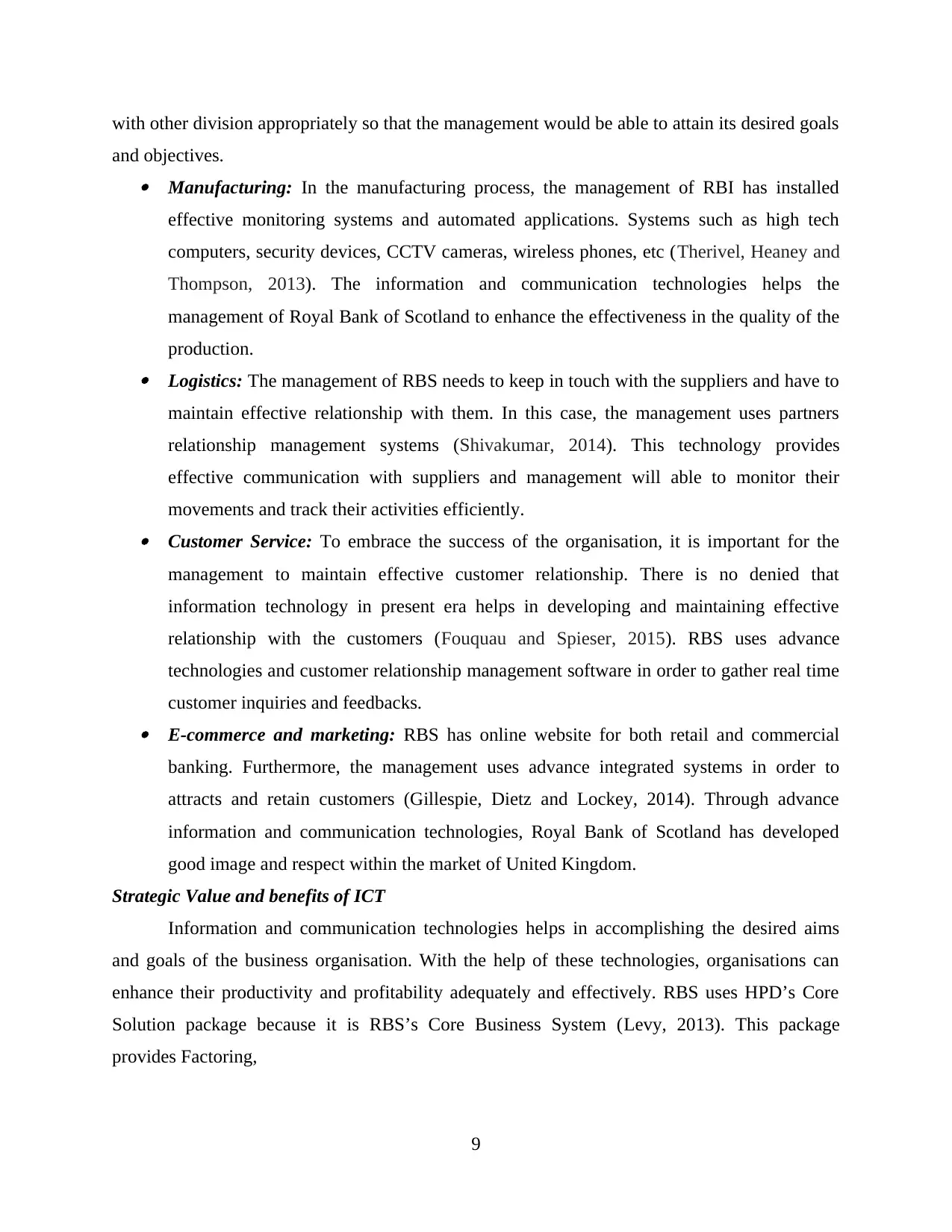
with other division appropriately so that the management would be able to attain its desired goals
and objectives. Manufacturing: In the manufacturing process, the management of RBI has installed
effective monitoring systems and automated applications. Systems such as high tech
computers, security devices, CCTV cameras, wireless phones, etc (Therivel, Heaney and
Thompson, 2013). The information and communication technologies helps the
management of Royal Bank of Scotland to enhance the effectiveness in the quality of the
production. Logistics: The management of RBS needs to keep in touch with the suppliers and have to
maintain effective relationship with them. In this case, the management uses partners
relationship management systems (Shivakumar, 2014). This technology provides
effective communication with suppliers and management will able to monitor their
movements and track their activities efficiently. Customer Service: To embrace the success of the organisation, it is important for the
management to maintain effective customer relationship. There is no denied that
information technology in present era helps in developing and maintaining effective
relationship with the customers (Fouquau and Spieser, 2015). RBS uses advance
technologies and customer relationship management software in order to gather real time
customer inquiries and feedbacks. E-commerce and marketing: RBS has online website for both retail and commercial
banking. Furthermore, the management uses advance integrated systems in order to
attracts and retain customers (Gillespie, Dietz and Lockey, 2014). Through advance
information and communication technologies, Royal Bank of Scotland has developed
good image and respect within the market of United Kingdom.
Strategic Value and benefits of ICT
Information and communication technologies helps in accomplishing the desired aims
and goals of the business organisation. With the help of these technologies, organisations can
enhance their productivity and profitability adequately and effectively. RBS uses HPD’s Core
Solution package because it is RBS’s Core Business System (Levy, 2013). This package
provides Factoring,
9
and objectives. Manufacturing: In the manufacturing process, the management of RBI has installed
effective monitoring systems and automated applications. Systems such as high tech
computers, security devices, CCTV cameras, wireless phones, etc (Therivel, Heaney and
Thompson, 2013). The information and communication technologies helps the
management of Royal Bank of Scotland to enhance the effectiveness in the quality of the
production. Logistics: The management of RBS needs to keep in touch with the suppliers and have to
maintain effective relationship with them. In this case, the management uses partners
relationship management systems (Shivakumar, 2014). This technology provides
effective communication with suppliers and management will able to monitor their
movements and track their activities efficiently. Customer Service: To embrace the success of the organisation, it is important for the
management to maintain effective customer relationship. There is no denied that
information technology in present era helps in developing and maintaining effective
relationship with the customers (Fouquau and Spieser, 2015). RBS uses advance
technologies and customer relationship management software in order to gather real time
customer inquiries and feedbacks. E-commerce and marketing: RBS has online website for both retail and commercial
banking. Furthermore, the management uses advance integrated systems in order to
attracts and retain customers (Gillespie, Dietz and Lockey, 2014). Through advance
information and communication technologies, Royal Bank of Scotland has developed
good image and respect within the market of United Kingdom.
Strategic Value and benefits of ICT
Information and communication technologies helps in accomplishing the desired aims
and goals of the business organisation. With the help of these technologies, organisations can
enhance their productivity and profitability adequately and effectively. RBS uses HPD’s Core
Solution package because it is RBS’s Core Business System (Levy, 2013). This package
provides Factoring,
9
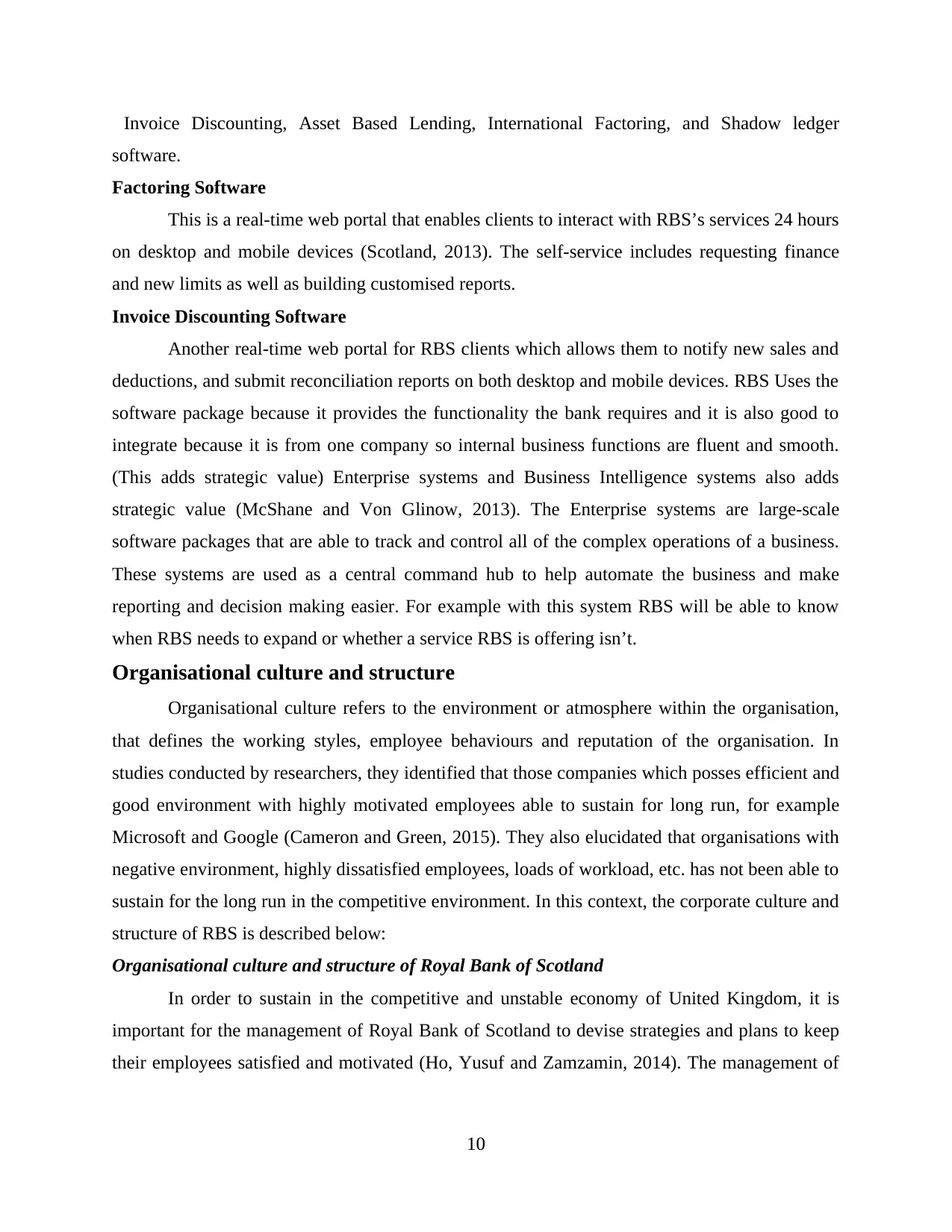
Invoice Discounting, Asset Based Lending, International Factoring, and Shadow ledger
software.
Factoring Software
This is a real-time web portal that enables clients to interact with RBS’s services 24 hours
on desktop and mobile devices (Scotland, 2013). The self-service includes requesting finance
and new limits as well as building customised reports.
Invoice Discounting Software
Another real-time web portal for RBS clients which allows them to notify new sales and
deductions, and submit reconciliation reports on both desktop and mobile devices. RBS Uses the
software package because it provides the functionality the bank requires and it is also good to
integrate because it is from one company so internal business functions are fluent and smooth.
(This adds strategic value) Enterprise systems and Business Intelligence systems also adds
strategic value (McShane and Von Glinow, 2013). The Enterprise systems are large-scale
software packages that are able to track and control all of the complex operations of a business.
These systems are used as a central command hub to help automate the business and make
reporting and decision making easier. For example with this system RBS will be able to know
when RBS needs to expand or whether a service RBS is offering isn’t.
Organisational culture and structure
Organisational culture refers to the environment or atmosphere within the organisation,
that defines the working styles, employee behaviours and reputation of the organisation. In
studies conducted by researchers, they identified that those companies which posses efficient and
good environment with highly motivated employees able to sustain for long run, for example
Microsoft and Google (Cameron and Green, 2015). They also elucidated that organisations with
negative environment, highly dissatisfied employees, loads of workload, etc. has not been able to
sustain for the long run in the competitive environment. In this context, the corporate culture and
structure of RBS is described below:
Organisational culture and structure of Royal Bank of Scotland
In order to sustain in the competitive and unstable economy of United Kingdom, it is
important for the management of Royal Bank of Scotland to devise strategies and plans to keep
their employees satisfied and motivated (Ho, Yusuf and Zamzamin, 2014). The management of
10
software.
Factoring Software
This is a real-time web portal that enables clients to interact with RBS’s services 24 hours
on desktop and mobile devices (Scotland, 2013). The self-service includes requesting finance
and new limits as well as building customised reports.
Invoice Discounting Software
Another real-time web portal for RBS clients which allows them to notify new sales and
deductions, and submit reconciliation reports on both desktop and mobile devices. RBS Uses the
software package because it provides the functionality the bank requires and it is also good to
integrate because it is from one company so internal business functions are fluent and smooth.
(This adds strategic value) Enterprise systems and Business Intelligence systems also adds
strategic value (McShane and Von Glinow, 2013). The Enterprise systems are large-scale
software packages that are able to track and control all of the complex operations of a business.
These systems are used as a central command hub to help automate the business and make
reporting and decision making easier. For example with this system RBS will be able to know
when RBS needs to expand or whether a service RBS is offering isn’t.
Organisational culture and structure
Organisational culture refers to the environment or atmosphere within the organisation,
that defines the working styles, employee behaviours and reputation of the organisation. In
studies conducted by researchers, they identified that those companies which posses efficient and
good environment with highly motivated employees able to sustain for long run, for example
Microsoft and Google (Cameron and Green, 2015). They also elucidated that organisations with
negative environment, highly dissatisfied employees, loads of workload, etc. has not been able to
sustain for the long run in the competitive environment. In this context, the corporate culture and
structure of RBS is described below:
Organisational culture and structure of Royal Bank of Scotland
In order to sustain in the competitive and unstable economy of United Kingdom, it is
important for the management of Royal Bank of Scotland to devise strategies and plans to keep
their employees satisfied and motivated (Ho, Yusuf and Zamzamin, 2014). The management of
10
⊘ This is a preview!⊘
Do you want full access?
Subscribe today to unlock all pages.

Trusted by 1+ million students worldwide
1 out of 18
Related Documents
Your All-in-One AI-Powered Toolkit for Academic Success.
+13062052269
info@desklib.com
Available 24*7 on WhatsApp / Email
![[object Object]](/_next/static/media/star-bottom.7253800d.svg)
Unlock your academic potential
Copyright © 2020–2025 A2Z Services. All Rights Reserved. Developed and managed by ZUCOL.





